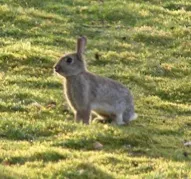
Experimental test of plant defence evolution in four species using long-term rabbit exclosures
Sometimes the best defence is a quick escape. Although this truism has long been recognized for animals, PhD student Nash Turley and former BIO481 student Teresa Didiano (Johnson Lab) recently showed that plants can escape too. Nash and Teresa just published “Experimental test of plant defence evolution in four species using long-term rabbit exclosures” in Journal of Ecology. Recent work shows that herbivores can drive rapid evolution of plant defences, but whether different plant species respond to common enemies in similar ways is poorly understood. In this study, Nash and Teresa excluded rabbits from British grassland plots for 0.3 to 34 years. In the presence of rabbits, three of the four species grew closer to the ground, a morphological feature thought to be an adaptation that allows plants to escape herbivores by “ducking”. In the absence of rabbits these same species evolved to be more upright, likely because of increased competition for light. One of the four species also evolved the ability to replace their tissue more quickly following grazing. These results show that multiple plant species can rapidly adapt to the presence or absence of herbivores, and that intense grazing selects for both convergent and unique defensive strategies in different plant species.
Congrats, Nash and Teresa!
